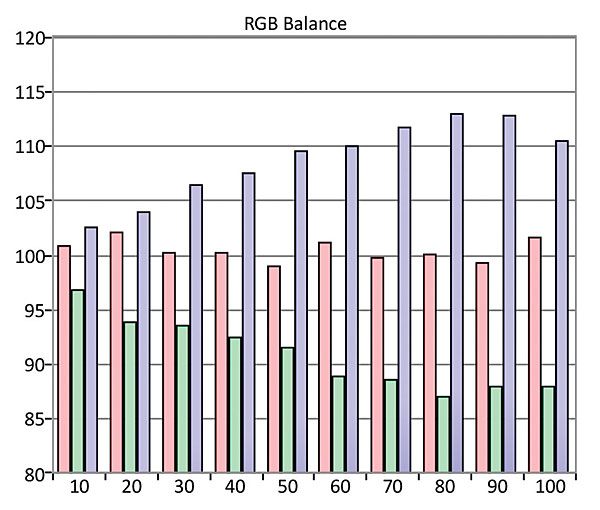Contrast is what makes OLED TVs excel on HDR, even though they can't match the brightness of top of the line LED tvs.
The same is the case for the new JVC-DLA line up of projectors when compared to the Sony 285ES or the Optoma new DLP4k, UHD65. The JVC beats them due to its excellent black levels and high contrast.
The Epson 5040 blows away its little sister the 4000 mainly due to the much improved black level and contrast.
The $500 price difference is worth it.
I know, I own an Epson 5040.
At current market price of $2,500 to $2,700 the Epson 5040 is a steal.
The 4000 at $2,000 to $2,200 has to compete against the Optoma UHD60 and its a loosing proposition.
Epson Home Cinema 4000 4K Enhanced 3LCD Projector Review Test Bench
Full-on/full-off contrast ratio in HD/SDR: 2,756:1
Measurements were made with SpectraCal CalMAN software, Photo Research PR-650 and Klein K-10A color meters, a Murideo pattern generator, and an Oppo UDP-203 Ultra HD Blu-ray player.


The contrast ratio above was measured in the Cinema Color Mode directly from my 96-inch-wide, 2.35:1, Stewart Filmscreen StudioTek 130 screen (gain 1.3)—Auto Iris on High Speed, Power Consumption (lamp) on Medium, projector at mid-zoom. Peak white level was 24.9 foot-lamberts, and black level 0.009 ft-L. With Auto Iris off, the contrast ratio dropped to 1,186:1. At full zoom (the largest possible image) and with the Iris on High Speed, the full-on/full-off contrast ratio measured 2,433:1, and at minimum zoom, 2,457:1.
In HDR, with Power Consumption (lamp) on High and the Auto Iris on High Speed, Contrast on 75, the full-on/full-off contrast ratio measured 3,016:1, due primarily to a higher peak-white level (the black level roughly doubled from the SDR reading).
With SDR gamma set to the –1 setting, gamma measured just a shade lower (brighter) than the BT.1886 SDR gamma standard. Pre-calibration, using the default Cinema mode, the white balance Delta E values ranged from a low of 7.73 at 20% to a high of 13.37 at 80%. Post-calibration, the low value was 1.99 at 80% and the high 8.66 at 100% (the latter was an outlier, with no other level higher than 3.05). The color point Delta Es peaked at 13.37 before calibration but were all below 1.64 after calibration, except for green at 5.38. Green was significantly oversaturated in SDR, and there wasn’t enough range in the CMS to bring it into line.
(Delta E indicates how close the color comes to the standard at each point in the brightness range. Values below 3—some experts allow for 4—are generally considered visually indistinguishable from ideal. From 3.0 to 10.0, most viewers will notice the deviations but will likely find them tolerable.)

In HDR, the best match to the EOTF (HDR gamma) curve came at a gamma setting of +2 and a Contrast setting of 95. Lowering the Contrast reduced high-level clipping but also lowered the pre-clipping EOTF curve, making the image in that region darker than designed. Any setting involved some compromise between accu- rate brightness and clipping, not uncommon in HDR and particularly with projectors. After calibration, the maximum HDR grayscale Delta E was 2.1 from 20% to 100%, except for the 40%-to-60% region (the “knee” of the EOTF—or HDR gamma—curve), where luminance deviations pushed the Delta E up to a maximum of 7.7 at 50%. The color point Delta Es, post-calibration, ranged from a low of 4.1 in red to a high of 8.67 in magenta. The peak white level in this situation was 174 nits, or 51 ft-L.
The peak HDR brightness onscreen varied little regardless of how much of the screen was covered in 100% white (10%, 25%, 50%, or 100%).—TJN
- Log in or register to post comments


Based on your knowledge of this projector and the Sony VPL HW30ES, would you say this is an upgrade in anyway or would the 5040ub be a better replacement ? Thanks.

Every HDR disc I've seen so far- Yes On HDR TV (A Sony flagship from a couple of years), have looked too exaggerated too fake and too unrealistic. Face it, HDR is not reality. If you look out your window, then look at the TV with HDR, you'll know exactly what I mean.

Watching movies at home is cool, but some things just hit different in a theater. I was looking at projectors like the Epson Home Cinema 4000 to get that big-screen feel at home, but I also checked out Fathom Events https://fathom-events.pissedconsumer.com/review.html since they show classics and special screenings in theaters. Some movies just aren’t the same on a couch, no matter how good your setup is. Still debating if I wanna go all-in on a home theater or just keep catching the good stuff on the big screen when it pops up.





























































